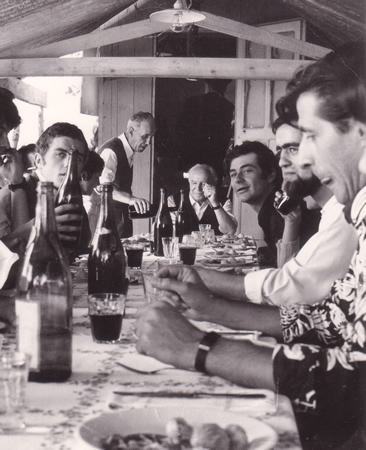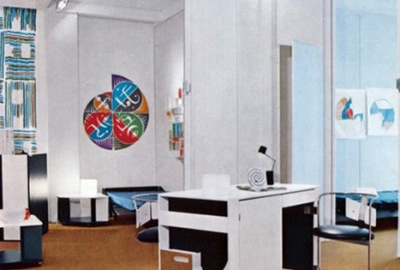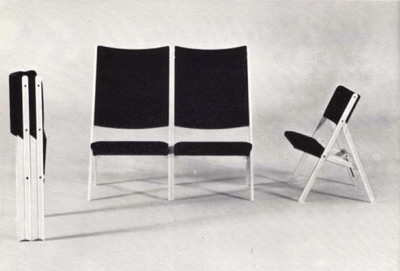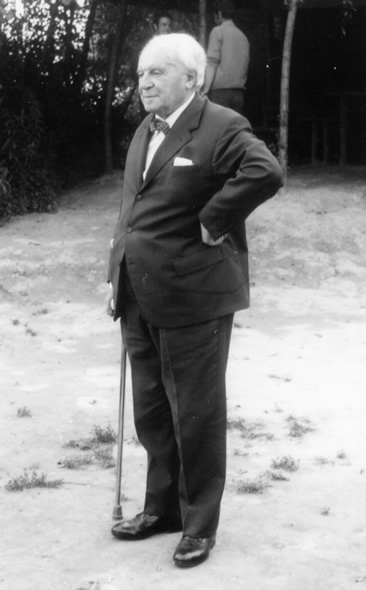Gabriella’s letter
The fortuitous meeting with Gio Ponti, a famous designer and architect from Milan, took place in 1967, when, inspired by the coincidence of names, Gio Ponti, who was on the crest of a wave by then, was consulted about a project of quality furniture, abandoning the hypothesis of focusing exclusively on quantity.
Everything was born as a result of the curiosity raised in the artist by a letter from Gabriella, Ermes Ponti’s wife, in which he asked Gio Ponti to make a drawing for the first piece of furniture “designed by an artist” of the company.
This is how design and “high” culture got into our company. Ponti answered immediately, as he was moved by the letter, which was also published in “Domus”, the furnishing, architecture and art magazine he founded and directed. He agreed to design a bedroom that we took to the Furniture Show in Milan, achieving great success, thanks to which we were able to expand our network of customers and to give the company visibility and credibility.
This has been an essential event for us: it has enabled us to understand the importance of the project, of design, of innovation not only when making the product but also when conceiving it. When Ponti came to us, he spent all the time at the workshop. We started from his project, we discussed, and we experimented together. It was a real Renaissance workshop experience.
Each project is based on a ongoing dialogue between the architect and the client.
Let’s see together how it’s possible.

The Apta series

In 1969, when Gio Ponti organised the “Eurodomus 2” furniture exhibition in Turin, he asked us to manufacture coffee tables. Evidently, he was pleased with that joint work, so much so that the following year in Milan when he presented the “Manifesto della Casa Adatta” (Manifesto of the Suitable House) as an economic residential model, he designed all the pieces of furniture of the Apta series for use. This was a solution of furniture that could be freely placed in the house. These pieces of furniture aroused the interest and the curiosity of the press and of experts; however, as it can be easily imagined, they did not meet with a favourable response by the public that was still not quite open to novelties.
Ponti’s heritage

These pieces of furniture are still requested for historical or anthological exhibitions, such as for the “Gio Ponti A World” anthological exhibition, first in London and Rotterdam and then at the Triennale in Milan (2002-2003), or the most recent one, “Domus Apta. Gio Ponti e il progetto di interni” (Domus Apta: Gio Ponti and the design of interiors) at the Politecnico di Milano University.
With Ponti, we have also collaborated for some of his private customers and we have made pieces of furniture for the cathedral of Taranto, which was designed by him. As he grew old, this collaboration turned into friendship – as it is evidenced by hundreds of letters between the Pontis of Mantova and the Pontis of Milan –, a relationship that still continues today, mainly with the children, Lisa and Giulio, and the grandchildren, Salvatore and Paolo.
Biography
Gio Ponti was born in Milan in 1891. In 1921, he graduated in architecture at the Politecnico di Milano University, after having interrupted his studies due to its participation in World War One.
Between ceramics and publishing
In the twenties, he started working as a designer in the Richard Ginori ceramics manufacturing industry, for which he reworked the overall industrial design strategy. With the ceramics, he won the “Gran Prix” in the Paris Exhibition of 1925.
Still during the 20’s, he also started working in the publishing sector and in 1928 he founded the Domus magazine. Except for a short period during World War Two, he never abandoned this activity. Domus, together with another famous magazine, Stile, represented the centre of the cultural architecture and design debate during the second half of the twentieth century.
Recognition
In the thirties, Ponti’s activity extended. He organised the V Triennale of Milan in 1933, designed the sets and costumes for the Teatro alla Scala, and was a member of the ADI, the Industrial Design Association.
He received a large number of national and international awards. In 1936 when he was already a successful professional, he became a tenured professor in the School of Architecture of the Politecnico di Milano University, and held such position until 1961.
The architect
In the fifties, his most intense and productive period in both architecture and design began. As a matter of fact, some of his most important works were done during these years.
The Pirelli Tower is one of them. It was built between 1955 and 1958 around a central structure designed by engineer Pier Luigi Nervi. The building looks like a slender, harmonious sheet of glass that is silhouetted against the skyline. It is the highest reinforced concrete skyscraper in the world (127.10 m).
In 1970, he created one of his last great works, the Co-cathedral of Taranto. Ponti was the originator, the site engineer and, in part, also the artist in this work, contributing his ideas for the interior design.
His last years
His work effort, which shows the versatility that characterised his creative mind in a lot of different fields during all his life, continued practically until he died in Milan in 1979.

For more information on Gio Ponti’s work:
- visit the Gio Ponti Foundation website.
- download the free application for iPhone and iPad of Sole 24 Ore dedicated to the Masters of Design



